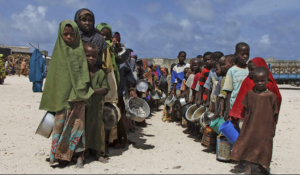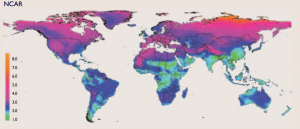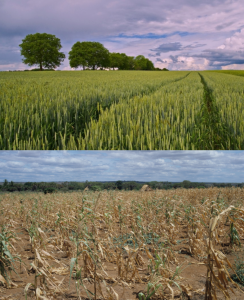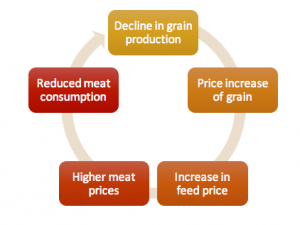By Hannah Lesbirel student at University of Southampton
You’ve all seen images of famine and the effect of crop failure on families across the globe. Have you ever pictured that being you? No, me neither.
Surely that can’t happen in the USA- “The greatest country in the World”- people say?

Some experts argue the increase in CO2 levels, associated with climate change, may in fact contribute to gains in some crops, in some regions of the world. Surely more CO2 means more photosynthesis, right?
However, the negative impacts associated with climate change are expected to reverse the potential benefits (Nelson et al., 2009). Climate change indisputably impacts: global temperatures, frequency and intensity of extreme weather events, CO2 levels and water availability, and without availability of sufficient water and nutrients photosynthesis can’t thrive (Nelson et al., 2009; Hatfield et al., 2011).
The video below summarises the limiting factors of photosynthesis and how they could be influenced by the changing environment.
Temperature Variability
The rate of plant development is primarily influenced by temperature, impacting (Hatfield and Prueger, 2015);
- Pollen viability
- Fertilisation
- Water requirements
- Grain and fruit formation
- Length of life cycle
All plants have an optimum temperature in which photosynthesis takes place, too high and enzymes are denatured and too low the catalytic efficiency of these enzymes are reduced. Additionally, higher temperatures are known to encourage weeds, pests and disease. The figure below shows the predicted temperature due to climate change globally by 2050 (Nelson et al., 2009). If this rise in temperature is to continue, this will reduce crop yields across the globe.


With warmer temperatures predicted along with the increased probability of extreme temperature events, plant productivity is at serious RISK! Estimations show a significant decline in yields, of between 80-90%, compared to ‘normal’ conditions (Hatfield and Prueger, 2015).
Changes in Precipitation
The concern of rising global temperatures, will be proliferated by changes in precipitation. Increasing the likelihood of crop failure and long term production decline (Nelson et al., 2009).
Despite uncertainty in precipitation change, under future climate change scenarios, the impact of excess and deficit amounts of soil water will be negative for crop production, either drowning or starving the crops of water (Hatfield et al., 2011).
It’s been said that “stronger interannual variability with more extreme year-to-year climate variations…[means] farmers are unable to tune their cropping systems to optimize resources (Bannayan et al., 2010).”
Not only will this have a major impact on human health and well-being. Agriculture contributes over $300 billion to the U.S. economy each year; think of the impact this may have on your health and livelihood.
Decline of Global Markets
On a more global scale, the potential decline in production will reach international levels, as U.S. farms supply 25% of all grain (soybean, wheat and maize) on the global markets (Nelson et al., 2009; USEPA, 2016).

The ‘domino’ effect of a decline in grain productivity is incomprehensible. The cycle that could follow is shows to the right.
Could we be building a wall between us and future generations? Progress is needed to prevent this shocking reality.
Read more information about the impact of Climate Change on global agriculture from the FAO report on Climate change: Impact on Agriculture and Costs of Adaptation.
[495 words]
- Bannayan, M., Sadeghi Lotfabadi, S., Sanjani, S., Mohamadian, A. and Aghaalikhani, M. (2010). Effects of precipitation and temperature on crop production variability in northeast Iran. International Journal of Biometeorology, 55(3), pp.387-401.
- Hatfield, J.L., Boote, K.J., Kimball, B.A., Ziska, L.H., Izaurralde, R.C., Ort, D., Thomson, A.M. and Wolfe, D. (2011) ‘Climate impacts on agriculture: Implications for crop production’, Agronomy Journal, 103(2), p. 351.
- Hatfield, J.L. and Prueger, J.H. (2015) ‘Temperature extremes: Effect on plant growth and development’, Weather and Climate Extremes, 10, pp. 4–10.
- Nelson, G.C., Rosegrant, M.W., Koo, J., Robertson, R., Sulser, T., Zhu, T., Ringler, C., Msangi, S., Palazzo, A., Batka, M., Magalhaes, M., Valmonte-Santos, R., Ewing, M. and Lee, D. (2009) Climate Change: Impact on Agriculture and Costs of Adaptation. Available at: http://www.fao.org/fileadmin/user_upload/rome2007/docs/Impact_on_Agriculture_and_Costs_of_Adaptation.pdf (Accessed: 1 March 2017).
- US EPA (2016) Climate impacts on agriculture and food supply. Available at: https://www.epa.gov/climate-impacts/climate-impacts-agriculture-and-food-supply (Accessed: 3 March 2017).
- YouTube. (2017). Factors That Affect the Rate of Photosynthesis | Biology for All | FuseSchool. [online] Available at: https://www.youtube.com/watch?v=1curtzL8rUM [Accessed 12 Mar. 2017].
Read More:
http://ecoethics.net/cyprus-institute.us/PDF/Rosensweig-Food-Supply.pdf
http://bioenv.gu.se/digitalAssets/1432/1432197_fantahun.pdf
http://www.pnas.org/content/106/37/15594.full
Recent Comments